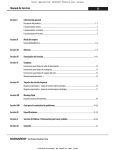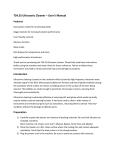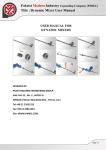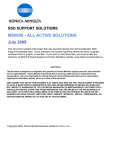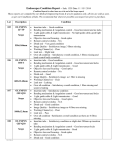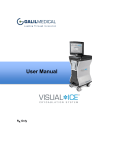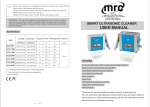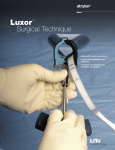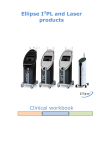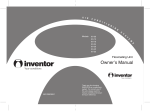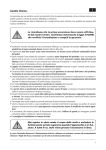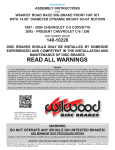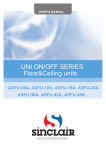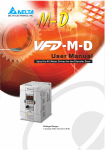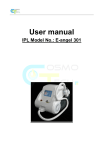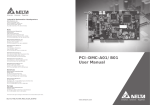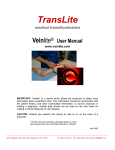Download USER MANUAL - Bono Electrolysis
Transcript
USER MANUAL This is the manual that was supplied with the "Telangitron." I have edited out most "T-tron" references. This manual will apply to nearly any standard Blend machine. USER MANUAL — REMOVAL OF TELANGIECTASIA — Using Blend Electrology Equipment "USER MANUAL" TELANGITRON ® Registered USA Trademark Mike Bono 1310 San Miguel Avenue Santa Barbara, CA 93109 USA phone: 1 (805) 962-5431 email: [email protected] User Manual P/N 19095-A Copyright©2010 Tortoise Press All rights reserved Please, read this ... • Do not operate your electrolysis unit without proper training. • You should not perform telangiectasia removal without having read Telangiectasia: Procedures to Remove Dilated Blood Vessels Using the Blend Method, by Michael Bono. Hands-on training is highly recommended (and may be available at a nearby electrology school). Individual training is available by Mike Bono. NON-PHYSICIAN DISCLAIMER: In the United States, a physician, or technician working directly under medical supervision may legally remove telangiectasia with an electrolysis unit. Presently, laws are rapidly changing that allow independent American therapists to perform this procedure. Several States have added telangiectasia removal to the list of appropriate esthetics procedures. However, it is up to you to find out the legalities in your area. In Europe, Australia, New Zealand, South America and Canada, nonmedical therapists, such as estheticians, are allowed to treat telangiectases. However, each regional authority has specific rules governing what can and cannot be done by nonmedical therapists. Unfortunately, in the United States, most of these laws are extremely vague. Some States have no licensing or rules governing this practice. In most American States, the subject of telangiectasia removal has rarely been discussed by governing bodies. However, if you are not a medical doctor, or not working under medical supervision, you should check with laws and medical authorities. Check these legal issues before purchasing any device or treating telangiectases with any electric needle device! Additionally, whether or not a needle is actually inserted into the skin has little bearing on the legality of this procedure. Do not be fooled by the "touch only" techniques: these are still destroying tissue. In fact, the "touch only" techniques destroy more tissue than the "fractionally inserted" Technique! "Touch only" techniques are MORE dangerous (see DVD and Textbook). INSURANCE: Be aware that if this procedure is specifically prohibited by law for nonmedical practitioners, your liability and malpractice insurance will probably not cover this procedure. We have found, however, that in States that allow this procedure, (and in unlicensed States with no rules) insurance companies ordinarily cover this practice at no additional cost. In fact, your best source of information, regarding the legality of this procedure, may be your insurance company. 2 DISCLAIMER: Please be aware that the information on page 2 is meant as a guide for you. We are unable to answer specific legal questions, because laws are different in each State and locality. However, it is important that you seek qualified legal opinion. • HISTORY/CLIENT CONSENT FORM: Always have patient/client fill out the History/ Patient Consent Form. Two sample forms are provided on the back of this manual. NOTE: Different State laws require added information not covered by this sample form. It is your responsibility to follow State law requirements. • PATIENT INSTRUCTIONS: Always have patient/client follow pretreatment instructions. A sample form is provided; see the last few pages of this manual. • Do not use on patients with the following condition (unless physician authorized): • Patient with heart or cardiovascular problems (pacemaker, etc.) • Patients with communicable diseases. • Patients with metal implants or braces. •Do not treat pregnant women (unless physician authorized). • Do not unplug components by pulling on the cord, always pull from the connector. • Needles are single use. Dispose of used needles according to appropriate sharps disposal procedures. Use an FDA approved sharps disposal container. Check with your local authorities for proper disposal of the "full" sharps container. You cannot simply toss needles or the sharps container in the regular trash! Used needles must be disposed properly; according to your local approved health regulations. ELECTRICAL SAFETY: • Your electrolysis device operates at 105-125 Volts, 50-69 Hz, 0.5 Amperes • To reduce the risk of shock, do not open your machine or remove any part of the enclosure. • Servicing and repair by authorized personnel only. • Your machine must be properly grounded at all times to avoid electrical shock. A grounded electrical cord is provided with your unit. • Do not operate this device close to water. Do not spill any fluids on the unit. TEL Needles The Ballet telangiectasia needles are STERILE. These are SINGLE USE needles ONLY! Use one needle on one patient. Do not touch the needle with your fingers. Do not touch the needle to any surface other than the patient's skin. If you accidentally touch the needle, dispose the needle and get a new one. After using the needle, dispose of the needle in an approved "sharps" container. Do not throw used needles in the regular trash; doing so is a violation of law! Collect used needles in the sharps container. (It may take years to fill the container.) When full, you cannot just throw the container in the trash; again, this is a violation of law. The sharps container must be properly discarded by a certified medical waste handler. A good idea is to have your cooperating physician dispose of sharps containers for you, since he/she already has a certified handler. Also, your local hospital will take your full sharps container for certified disposal — usually at no cost at all. 3 Typical Electrolysis Unit Front Panel ... DC METER You may glue PROBE CORD CLIP here DC INDICATOR LIGHT HF INDICATOR LIGHT High Frequency HF CONTROL KNOB DC CONTROL KNOB Direct Current Direct Current + JACK - JACK POWER LIGHT DC TEST SWITCH Phoresis roller Probe cord Accessory cord You are supplied with: ! 1 Hand-held ground ! 2 Accessory cords ! 1 Probe cord ! 1 Phoresis roller POWER SWITCH Hand-Held Ground Ac 4 ce ss or yc or d Typical Electrolysis Unit Back Panel ... High Frequency JACK High Frequency HF THERMOLYSIS FOOTSWITCH FOOTSWITCH Direct Current JACK 105-125 Volts, 50-60 Hz, 0.5 Ampere SERIAL NUMBER: Distributed by: Edge Systems Corporation Signal Hill, CA 90806 Phone: 562-988-1175 FAX: 562-988-1195 Direct Current DC ELECTROLYSIS FOOTSWITCH FOOTSWITCH TO REDUCE THE RISK OF SHOCK, DO NOT OPEN THIS MACHINE OR REMOVE ANY PART OF THE ENCLOSURE. SERVICING AND REPAIR BY AUTHORIZED PERSONNEL ONLY. L5-712 THIS MACHINE MUST BE PROPERLY GROUNDED AT ALL TIMES TO AVOID ELECTRICAL SHOCK. POWER CORD HF THERMOLYSIS FOOTSWITCH CORD & PLUG* DC FOOTSWITCH CORD & PLUG* *Note: The footswitch plugs can only be inserted into the jacks one way. If the plug will not go in easily, turn it over and try again. The plug will lock into the jack when properly inserted. 5 Typical Electrolysis Unit Accessories NEEDLE-HOLDER, PROBE CORD (1) The needle-holder is specifically sized to take the standard telangiectasia needles. CLIPS FOR PROBE CORD & HAND-HELD OUTLETS (2) You are usually supplied with two (2) black rubber clips for your needle-holder (and hand-held ground) — and a tube of super-glue. Just glue the clips to the machine, wherever you want them. BANANA PLUG ACCESSORY CORDS (2) You are usually supplied with two (2) banana plug accessory cords. The cords are similar to a coiled telephone cord (coiled to avoid accidental pulling and wire breakage). The plugs look like bananas, hence the name. Use the accessory cords for the hand-held ground and the phoresis roller. HAND-HELD GROUND (1) You are usually supplied with one (1) hand-held ground. This is a simple metal cylinder that plugs into an accessory cord and is then plugged into the RED or Black (+positive and -negative jacks) outlets. You will use the same ground for telangiectasia removal and for cataphoresis. Simply plug the ground into the respective RED or BLACK outlet for the specific operation. PHORESIS ROLLER (1) You are usually supplied with one (1) phoresis roller. The phoresis roller looks like a tiny paint roller and is used to perform cataphoresis. You will only be performing cataphoresis with your Blend unit. Therefore, your phoresis roller will always be plugged into the (+ positive jack) outlet. FOOTSWITCHES (2) You are usually supplied with two (2) footswitches: one for the HF and one for the DC. The footswitches plug into the back of the unit. The unithas one (1) electrical (AC) power cord attached to the machine. 6 Telangiectasia removal Setup for Telangiectasia removal: ! Attach the probe cord to the BLEND outlet. ! Plug the hand-held ground (with accessory cord) into the RED (+positive) outlet. ! Place a wet "baby wipe" or wet towel around the hand-held ground. Use regular tap water — not distilled. ! Loosen the tip of the needle-holder and place a needle in the holder. Tighten securely. ! Recommended needle size: Standard Ballet Tel .003 needle for all telangiectasia removal applications. Basic Procedure: ! Preset the HF current to "your lowest setting" for small to medium telangiectases.* You may use more current for larger vessels. ! Preset the DC current to 0.2 or 0.3 milliamperes for small to medium telangiectases. You may use more current for larger vessels, but usually no more than 0.4 milliamperes is needed. ! Follow instructions found in Bono's book Telangiectasia. Be sure that you understand both the "Basic Procedure" and the "Modified Basic Procedure," as explained in the book. These techniques are your primary operating procedures. Cataphoresis: ! Cataphoresis aftercare is seldom necessary following telangiectasia treatment. However, if the area appears exceptionally red and swollen, you may use cataphoresis. (Cataphoresis diminishes edema, erythema and reduces posttreatment pain.) ! Plug the phoresis roller (with accessory cord) into the (+ positive jack) outlet. ! Plug the hand-held ground (with accessory cord) into the (- negative jack) outlet. ! Preset the DC meter to 0.5 to 1.0 milliamperes (5 to 10 on your meter). ! Place wet cotton gauze on the treated area (use tap water or witch hazel). ! Turn on the DC (with footswitch) and gently roll the phoresis roller over the gauze-covered area for about 2 to 3 minutes. * The lowest setting will be different on different electrology units. If you are not certain, ask the manufacturer where to put the HF dial to have the lowest recommended HF output. Remember, you need very little current to successfully treat teles. 7 Working ranges on a Typical Electrolysis Unit di ca to rl ig ht Always start at "low" on the HF output ... H F in HIGH FREQUENCY (HF) LEVELS H F D ia l For telangiectasia removal your HF working range is between "low and medium" ALWAYS start at your lowest HF setting. START M 0. ete 3 r m is illi sh am o pe win re g s Telangiectasia working range on the Telangitron® DIRECT CURRENT (DC) LEVELS Direct Current D C D ia l D C in di c at or l ig ht For telangiectasia removal, your DC working range is between 0.2 and 0.4 milliamperes. Use 0.2 to 0.3 milliamperes for small to medium telangiectases; use 0.3 to 0.4 for large telangiectases. 8 NOTE: The DC meter on this machine reads in tenths. Therefore, "4" on the meter is actually 0.4 milliamperes (or 4 tenths of one milliampere). A few suggestions ... Over the years I have trained numerous practitioners. I have observed both new and veteran therapists, and have noticed several recurring errors. For the most part, the therapist usually performs what I would term a "timid treatment." That is, she uses too little current, does not insert the probe deep enough and doesn't produce enough coagulated segments to ensure a successful treatment outcome. I think that therapist are inherently fearful of electrical currents and anything that looks like a needle. They are fearful of hurting the patient. Thus, they treat telangiectasia insufficiently. They are also not as knowledgeable about the skin as they should be — despite having attended school. They know very little about the way normal skin heals. They often become upset when they see inflammation, swelling and crusting; even though these manifestations are just part of the normal healing process. By contrast, physicians are fearless. They are also familiar with the healing process and can advise patients that most posttreatment manifestations are normal and will resolve without incident. If you are a therapist working independently or in a doctor's office, I suggest that you read literature dealing with the skin's healing process. Focus on the inflammation process: the normal way skin heals following injury. The inflammation process is a minor miracle that you should know about in depth. Educational material is readily available in your local medical library. You might ask your cooperating physician to suggest a title for you. Most importantly you must sufficiently treat the telangiectases. Here's the problem that you must understand: You can just touch the skin with the probe in a few places and completely miss the vessel. You can use insufficient current, or no current at all. In spite of these errors, the localized edema (swelling) from your "poking" will cause the telangiectases to temporarily disappear. In this way, you think that your treatment was successful. However, within a few days the inflammation subsides, the vessels reappear and the patient thinks the treatment failed. (Review the DVD to see proper skin treatment.) You must use enough current to see some reaction to the skin's surface. Although you seem to be just "touching" the skin with the needle, you must insert deep enough to actually enter the blood vessel — yes, this is a mere fraction of a millimeter. Furthermore, you must coagulate the entire length of each A) Normal telangiectasia before treatment. B) The technician has completely missed the target. She inserted near the blood vessels, but not into them. She used too little current, because she was afraid of hurting the patient. C) Even though she has made these errors, the immediate swelling from the low current and the probe entering the skin causes the telangiectasia to disappear. The patient is happy, but within a few days the telangiectasia reappears as the swelling diminishes. 9 blood vessel, not just treat here and there. Sometimes you will discover that as you treat a vessel, much of it disappears. When this happens you must remember where the vessel was and coagulate the entire (invisible) length. Indeed you will see redness, swelling and tiny crusts after the treatment, and it may take a few days for the skin to calm down. However, you must perform successful treatments without being fearful of normal skin reactions. Typically, this techniqueTechnique will cause some localized inflammation. After the primary edema (swelling) subsides, say in a day or so, the inflammation process will continue as the skin heals. The inflammatory process itself causes tiny blood vessels in the area to dilate to carry more blood to the healing tissues. Therefore, is it very normal for the patient to experience "more" pronounced blood vessels in the area (for up to 2 weeks or so in some patients). You must inform the patient that this phenomenon is part of the normal healing process. Do not retreat the area too soon in an attempt to diminish these normal inflammation-caused dilated vessels. Wait at least 3 to 4 weeks, until the inflammation is gone, reevaluate the area and then treat the remaining telangiectasia. For an in-depth study of these processes please refer to my main text. I have made this drawing large to impress upon you that you MUST coagulate the entire length of each vessel and you MUST be on target. 10 A Quick Start ... Direct Current to ter 3" "0. High Frequency e set m DC Direct Current set HF l dia " low to " Start on a relatively tiny threadlike vessel on the face. Set your HF Thermolysis to low, and set the DC direct current to 3 tenths (see illustration above). Gradually increase the HF as needed. HF is correctly set when the vessel coagulates in about 1 to 2 seconds. If coagulation is taking longer, you are not using enough HF. Any faster than 1 second, and you may be using too much HF. The DC setting will range between 3 and 4 tenths (You don't need much DC, because you are only using the DC to enter the vessel and to release the needle from the coagulated clot. Use the standard Ballet Tel needle (.003). I usually bend the needle to a 45 degree angle. Bending allows me to insert the needle straight into the vessel; not at a low angle. (Bending the needle is covered in my book.) Start off by completely coagulating one noticeable vessel. Be sure you coagulate the whole thing. If you are not sure of yourself, treat only a few vessels — you can always remove more at another time. You will gain confidence as you get more experience. Pick the Right Patient Especially when you are starting out, pick cases that will be easy and successful. The Blend unit works best on tiny threadlike vessels on the face and upper body. Larger vessels are also effectively treated, especially the dot-like hemangiomas on the face and upper body. Additionally, the American Academy of Dermatology has Stated that requests for telangiectasia removal is the number two requested treatment (number one is acne treatment). So, why waste your time, or risk treatment failure by treating leg vessels? If you think you cannot treat a vessel because it looks too daunting — don't treat it! Start conservatively and learn what you can and cannot do. Limit yourself to common solar telangiectasia, found on light-skinned people, that were environmentally caused by sun and temperature extremes. Other treatments with the Blend unit? Yes, you can do other procedures with the Blend unit such as milia, skin tag and "brown spot" removal. However, there are better treatments for these lesions. Performing such tasks may be very much outside your scope of practice. You may perform "galvanic facials" with your blend unit if that is your specialty. 11 Quick Reference Card Photocopy or tear out this card and keep it in your work area. Use it as a quick reference until you become completely familiar with all the procedures. NEEDLE SIZE: .003 stainless steel telangiectasia needle. MACHINE POWER: HF: DC: • BASIC PROCEDURE: Insert with DC only. Coagulate with HF and DC. Remove needle with DC only. • MODIFIED BASIC PROCEDURE: Insert with DC Coagulate with HF only. Remove needle with DC only. EXTENSIVE CONDITION: 12 low for thread size. medium for larger vessels. 0.2 to 0.3 milliamperes for thread size. 0.3 to 0.4 milliamperes for larger vessels. Insert with HF and DC. Coagulate with HF and DC. Remove needle with HF and DC. SPIDER TELANGIECTASIA: Use basic procedure unless bubbles seen. DOTTELANGIECTASIA: Use basic procedure unless bubbles seen. Coagulate as spider center. BLOOD-MOLE: Use basic procedure unless bubbles seen. RED BLOTCH: Treat randomly. DC ONLY PROCEDURE: Try for extremely small vessels only. DC : 0.2 to 0.3 milliamperes. Blend method: the currents Please read the summary below to familiarize yourself with the HF and DC currents for telangiectasia removal. Direct Current (DC): ! Direct current (DC) produces NaOH (Sodium Hydroxide — lye) at the needle. ! The lye chemically dissolves tissue and allows the needle to easily penetrate the skin and blood vessel during insertion. ! The lye also dissolves material around the coagulated clot and allows you to easily withdraw the needle from the clot. ! The patient must hold the hand-held ground with a wet cloth around the ground. Do not use distilled water — use tap water. You may use a "baby-wipe" disposable towel. A dry hand-held ground will not correctly conduct the DC current. High Frequency (HF Thermolysis): ! High frequency (HF) produces heat at the needle. ! The HF causes tissue to coagulate, and forms a barrier to blood flow that ultimately eliminates the telangiectasia. ! Although the hand-held ground is not necessary for HF current, it is a good idea to use the hand-held ground at all times during the treatment (even if you are using the HF alone). ! HF causes most of the tissue destruction. Therefore, be sure your working range is properly selected — not too high. It is better to start with too little HF than too much. Average HF working range should be "low." Cataphoresis (+CATA): ! Cataphoresis is the application of the positive pole of DC to the skin. ! Cataphoresis reduces posttreatment pain, and diminishes edema and erythema. Anaphoresis (-ANA): ! Anaphoresis is the application of the negative pole of DC to the skin. ! Anaphoresis increases pain and erythema. Anaphoresis is used in some "beauty therapy" procedures to "force" chemicals into the skin by electro-phoresis. Anaphoresis is never used following telangiectasia treatment. 13 Galvanic* Skin Treatments *"Galvanic" means DC (direct current): a stream of electrons moving in one direction, from negative - to positive + The Unit also provides galvanic skin treatments. Using DC is greatly beneficial after microdermabrasion! DC also calms the skin after telangiectasia removal with the Blend. Commonly Used Terms: Cataphoresis +: Using the positive + as the active electrode. Think of this as a POSITIVE treatment in that it feels good, makes the skin look less red and + calms the skin. You can think of petting a “cat” which makes you feel good — “CAT”-a-phoresis. (Technically, term refers to cathode.) Iontophoresis +: (Esthetics term) Using the positive electrode, various products are “forced” into the skin. Used for sensitive aging skin. - Anaphoresis -: Using the negative - as the active electrode. Think of this as a NEGATIVE treatment in that it feels irritating, makes the skin red and stimulates the skin. You can think of this as that nasty old “Ana” — that mean old aunt of yours — “ANA”-phoresis.” (Technically, term refers to anode.) Disincrustation -: (Esthetics term) Using the negative electrode, for acne-prone skin. The negative pole liquefies sebum and makes comedo extraction easier. Irritates and increases blood flow to skin. In some acne-prone cases, treatment can worsen the condition. + MICRODERMABRASION: Use cataphoresis after microdermabrasion (the + DC current). Put a Vitamin C product on the skin and gently work it in with the roller (no pad necessary). This is sometimes called iontophoresis or ionic-treatment. The current forces the Vitamin C into the skin and also greatly soothes the skin after microdermabrasion. + TELANGIECTASIA: You may also use cataphoresis after a blood vessel treatment. Place a wet 4 X 4 cotton pad on the skin (use Witch Hazel or other soothing product). Gently move the roller over the treated area to help calm the skin and remove posttreatment redness. Feels good! + SET-UP: Plug the ACTIVE electrode (roller) in the positive + outlet. Plug the hand-held electrode in the negative - outlet. Set the DC to between 5 and 10 on the meter. Press down on the DC footswitch and roll over the treated area for about 5 to 10 minutes. Direct Current DC: 5 - 10 “active” roller electrode 14 Copyright © 2003 Tortoise Press Skin Tags* *Benign epidermal hyperplasia — Removal with Blend unit — SKIN TAG: a benign (not cancer) overgrowth (hyperplasia) of the epidermis (the outermost layer of skin). Skin tags are common on areas that experience friction, such as the underarm and neck. Because they are epidermal, they are totally bloodless and (lacking melanocytes) appear white in color. Skin tags also have very few nerve endings — again, because they are an overgrowth of epidermis. LEGALITY: As with any tissue removed from the skin, biopsy should be performed. Furthermore, removal of skin tags, while very easy, probably constitutes the practice of medicine in the United States. These should not be removed without medical supervision. (Although in Europe, Australia and New Zealand, the practice of skin tag removal is legal for therapists.) PROCEDURE: Use high HF power, and set the DC to 5 or 10 (meter reading). Firmly grasp the top of the skin tag with your tweezers (you may hold hard, because the patient cannot feel the tweezer — no nerves, remember?). Hold both currents ON and use the tip of the needle like a scalpel. Use a back and forth motion and cut through the skin tag. About half way through, you may encounter some tough elastin fibers — just cut through these fibers and remove the entire skin tag. APPEARANCE AFTER TREATMENT: There should be no bleeding at all. There should be little skin tag material left. You should leave a “cut out” depression in the skin, where the tag was removed. The epidermis will quickly bridge this wound gap (epithelization) and, in most cases, the skin tag will not grow back. In predisposed patients, new skin tags will eventually form in other areas. HF: HIGH DC: 5 - 10 Copyright © 2003 Tortoise Press 15 Easy maintenance Plug Receptacle (hole) HAND-HELD GROUND Periodically, buff the surface of the hand-held ground with dry steel wool to avoid corrosion and dulling. Clean inside the ground (the hole). Clean inside the hole with alcohol and a Q-tip. (If the ground or plug receptacle is badly corroded, the DC will not flow. You may have to replace the entire hand-held ground.) Reassemble the ground by reinserting the banana plug accessory cord. Plug Receptacle (hole) PHORESIS ROLLER Every so often, buff the phoresis roller with dry steel wool to avoid corrosion and dulling. Periodically soak the phoresis roller in hot soapy water for 10 minutes. Swish around in the soapy water and rinse; thoroughly dry and sanitize. Clean inside the handle with alcohol and a Q-tip. (If the phoresis roller is badly corroded, the DC will not flow: replace the phoresis roller.) Do not autoclave the phoresis roller! BANANA PLUG ACCESSORY CORD Now and then, clean the banana plugs with alcohol. Avoid extensive stretching of the cords. Repeated stretching breaks the wire. NEEDLE-HOLDER, PROBE CORD With normal use, the probe cord wire eventually breaks or frays. If there is intermittent current, or no current, replace the probe cord. Purchase a new probe cord each year, because nearly all "problems" arise from a broken or worn out cord. Avoid excessive stretching of the probe cord. FOOTSWITCHES Dust buildup can cause the electric contacts inside the footswitches to malfunction. Periodically brush or blow out the accumulated dust, and wipe the outside surfaces. When not in use, store footswitches off the floor to avoid dust buildup. Don't overstretch the cords. 16 Simple troubleshooting " to set "10 meter should rise smoothly Direct Current METERS Hold down the DC test switch and turn the DC control knob to "10" on the meter. The meter should rise smoothly. Release the test switch and the meter should return to "0." Press the test switch again. The meter should rise smoothly to "10." Erratic movement on the meter indicates a problem. Contact the manufacturer/distributor. bend here FOOTSWITCHES Preset the DC Dial to "10." Plug each footswitch, one at a time, into the DC jack receptacle. Depress the DC footswitch and gently bend the cord back and forth at the plug, and at the base of the footswitch. If the DC meter stays at "10," without fluctuating, the footswitch is good. metal "pin vise" bend here PROBE CORD Preset the DC meter to "5." Attach the probe cord to the BLEND outlet. Plug the hand-held ground (and accessory cord) into the RED (+ positive jack) outlet. Wrap the hand-held ground with a moist towel. Remove the tip of the needle holder and place the metal "pin vise" on the towel. Depress the DC footswitch; the DC meter should rise smoothly to "5." With the DC current on and the "pin vise" on the towel, bend the probe cord back and forth at the outlet, and at the needle holder. If the meter does not fluctuate, the cord is good. If the meter fluctuates, there is a break in the wire. Replace the probe cord. HAND-HELD GROUND Preset the DC meter to "5." Plug the hand-held ground (and an accessory cord) into the BLACK (-negative) outlet. Plug another accessory cord into the RED (+ positive jack) outlet. Touch the banana plug of the accessory cord to the bare metal ground. Turn on the DC with the footswitch. Press the banana plug firmly to the ground and randomly slide it over the entire surface of the ground. If the DC meter fluctuates considerably, the ground has "dead spots" and may need to be cleaned or replaced. jiggle cord up and down BANANA PLUG ACCESSORY CORDS Preset the DC meter to "5." Test an accessory cord by plugging one end into the RED (+ positive jack) outlet, and the other end into the BLACK (-negative jack) outlet. Depress the DC footswitch. The meter should rise smoothly. With the DC on, jiggle the accessory cord up and down to detect a partially broken wire. If the meter does not fluctuate, the cord is good. If the meter fluctuates replace the entire cord. 17 Patient consent form: Vascular Blemishes Our technique should improve your vascular blemish condition. Treatment is more successful with facial and upper body vascular blemishes than legs. We may not be able to remove all the unwanted vessels at one appointment. A few treatments may be necessary. You may be predisposed for vascular blemish formation, and may develop more in your lifetime. You may have to see us every year or so to keep up with the new blood vessel formation. You should not expect 100% removal of all of your vessels; particularly if you have a large number of vascular blemishes. You will experience some redness following treatment that may last 24 hours or longer. For a few days after treatment, the area may appear to have dilated vessels remaining in the area; this is temporary and caused by the inflammation. Some people show little redness and others get quite florid from treatment. Tiny crusts will form that will last 7 to 10 days or longer. In some cases, you may experience temporary darkening of the skin where the vessels have been removed. These will appear as tiny brown dots. In rare cases, marking can persist for up to 6 months — but always disappears. Indeed, we have products available to hasten the disappearance of pigmentation. You must carefully follow aftercare instructions and keep the area clean. Understanding these nominal risks, I consent to have this procedure performed ... Please sign here 1) Last name: 2) Age: Date First name: Sex: Height: Weight: 3) Have you eaten within the last few hours? YES NO (sometimes patients who have not eaten experience a bit more treatment pain.) 4) Is there a personal or family history of the following (please circle any that apply): bruise easily bleeding or clotting problems prolonged bleeding thrombophlebitis (blood clot with or without swelling) 5) Do you smoke? YES NO 6) Is your face or body exposed to excessive sunlight? YES NO 7) Do you usually wear sunscreen? YES NO 8) Do you commonly engage in winter sports such as skiing? YES NO 9) Are you blond and blue-eyed? YES NO Short From Copyright©2010 Tortoise Press 1 10) Do you work/play outdoors? YES NO 11) Do you wear a hat when outdoors in the sunlight? YES NO 12) Do you use Retin-A? YES NO 13) Do you regularly have aesthetic treatments? YES NO 14) Do you use a puff-buff or other skin exfoliating device? YES NO 15) Do you squeeze blackheads or pimples on your face? YES NO 16) Do you regularly take vitamins? YES NO 17) Do you take Vitamin C on a regular basis? YES NO 18) Are you a strict vegetarian? YES NO 19) Are you currently taking any type of hormone? If so, what kind? YES NO 20) When you cut, scratch, burn or abrade your skin, do you develop brown splotches in the area? YES NO 21) Has your skin developed brown spots, melasma or splotching during pregnancy or while taking the birth control pill? YES NO 22) During pregnancy, did you develop tiny, blush-like red spider veins? YES NO 23) After any blow or trauma to your legs, did you ever develop tiny blush-like red spider veins? YES NO 24) Is there a family history of spider and varicose veins or "broken capillaries." YES NO 26) Are you still developing new vascular blemishes: YES NO 27) Have your vascular blemishes ever been treated YES NO 28) Do you have a history of scarring after treatment of your vessels? YES NO 29) Did you develop small red vessels (blush-like) after laser treatment? YES NO 25) How many years have you noticed your unwanted vascular blemishes? 2 Patient consent form: Vascular Blemishes Please read and fill in all 7 pages No medical technique is perfect and no two people are alike. Accordingly, the treatment of vascular blemishes ("broken capillaries" and spider veins) with the electrolysis unit technique should improve your condition, but will not produce miracles. Generally, we have found that treatment is more successful with facial and upper body vascular blemishes than on the legs. Blood vessel removal on the legs is only about 50% successful; with less success the lower you go on the legs. We may not be able to remove all the unwanted vessels at one appointment — this is done for your safety. Thus, a series of treatments may be necessary (usually 2 to 4). You may also be genetically predisposed for vascular blemish formation, and will develop more of them in your lifetime. You may, for example, be fair-skinned and spend a lot of time outdoors and thus develop more vascular lesions. In such a case, you will probably have to see us every year or so to keep up with the new blood vessel formation. You should understand the disadvantages before you undergo this procedure. First, a few treatments may be necessary and you should not expect 100% removal of all of your vessels; particularly if you have a large number of vascular blemishes. With facial and upper body telangiectasia, results will be seen rapidly. In most cases, the vessel will disappear immediately. You will, however, experience some redness following treatment that may last 24 hours or longer. For a few days after treatment, the area may appear to have dilated vessels remaining in the area; this is usually temporary and caused by the inflammation. Redness depends on your skin type. Some people show little redness and others get quite florid from treatment. You will also get tiny crusts on the face and body that will last 7 to 10 days or longer (body crusts last longer, up to 3 weeks). As mentioned, success on the legs is not as good as on the face or body. However, in most cases some improvement will be seen. Indeed, posttreatment risks are substantially less with the our process than with either sclerotherapy (injection) or with laser. In most cases we have seen that the leg vein will return, but about 50% thinner than before treatment. It may take several weeks for the vessel to diminish after your treatment. Elimination of all leg veins is seldom accomplished. We must use more current to remove leg veins, so crust size will be much larger than on the face; and crusts will last longer — up to 3 weeks or so. (We may elect to use local anesthetic for treating your leg vessels, and you will wear an ace bandage for at least 24 to 48 hours following treatment.) It is possible that the veins will look worse before they appear better; although once crusts fall off there should be a noticeable difference. Bruising is uncommon, but possible, and swelling should be expected, particularly if you have large numbers of vessels to be treated. In some cases, the leg vessel will be replaced by a visible scar — although the scar is usually preferable to the vessel itself. Long From copyright©2010Tortoise Press 1 In some cases, you may experience temporary darkening of the skin where the vessels have been removed (face, body and legs). We have not yet seen a case where this is permanent, but the marking can persist for up to 6 months. Indeed, we have products available to hasten the disappearance of pigmentation if the need arises. On the legs, this may appear as brown streaks or brown patches where the vessels were treated. On the face this will appear as tiny brown dots. As mentioned, we expect pigmentation to be temporary, but it could be permanent in your case — although this would be rare. Sores or ulcers seldom occur; a result of posttreatment infection. Thus, you need to carefully follow aftercare instructions and keep the area clean. Infection can lead to dot-like scarring. Infection or other posttreatment problems are commonly treated with anti-inflammatorily medications and/or antibiotics. Finally, we have recently discovered that having had prior treatment, with sclerotherapy, laser or hyfrecator, can create "treatment resistant" blood vessels that may require significantly more treatments. And, treatment of such vessels my not be successful. Please be sure that you discuss any prior treatments with either the physician or technician! Photographs are necessary to document the progress of this procedure. I understand this and agree to have photographs taken, and I also agree to these being used for training and educational purposes. I have read the above and understand the potential benefits, limitations and risks of treatment. Understanding these risks, I consent to have this procedure performed. Patient (please sign and print your name) Date Witness 2 Date: 1) Last name: 2) Age: First name: Sex: Height: Weight: cle se cir ea pl 3) Were you referred to me? YES NO YES NO YES NO If referred, by whom? 4) Have you eaten within the last few hours? (sometimes patients who have not eaten become dizzy after treatment.) 5) Are you pregnant or planning to get pregnant in the near future? 6) Do you have a history of (please circle any that apply): Infection septicemia HIV allergy to aspirin hepatitis lupus collagen vascular disease heart problems migraine headache low blood pressure high blood pressure diabetes pulmonary emboli any known allergy 7) Is there a personal or family history of the following (please circle any that apply): bruise easily bleeding or clotting problems prolonged bleeding thrombophlebitis (blood clot with or without swelling) cle se cir ea pl 8) Do you smoke? If so, for how long? If so, how many packs per day? YES NO 9) Could you walk 3 miles continuously for 1 hour? YES NO 10) After walking, have you ever noticed (please circle): heaviness tiredness fatigue swelling leg cramps restless legs throbbing other symptoms 3 cle se cir ea pl 11) Are you required to be on your feet for long periods of time? YES NO 12) After standing, do your legs ache? YES NO 13) Do you have a history of swelling in the legs or feet? YES NO 14) Do you do any type of exercise that causes violent physical pounding in your legs, such as aerobics or running? YES NO 15) Are you menopausal? YES NO 16) Do your veins get worse during your periods? YES NO 17) Is your face or body exposed to excessive sunlight? YES NO 18) Do you usually wear sunscreen? YES NO 19) Do you commonly engage in winter sports such as skiing? YES NO 20) Are you blond and blue-eyed? YES NO 21) Do you work/play outdoors? YES NO 22) Do you wear a hat when outdoors in the sunlight? YES NO 23) Do you use Retin-A? YES NO 24) Do you regularly have aesthetic treatments? YES NO 25) Do you use a puff-buff or other skin exfoliating device? YES NO 26) Do you squeeze blackheads or pimples on your face? YES NO *27) Do you regularly take vitamins? YES NO *28) Do you take Vitamin C on a regular basis? YES NO *29) Are you a strict vegetarian? YES NO *30) Do you occasionally eat red meat? YES NO *These questions are for our research. Several clinicians have noted that strict vegetarians appear more prone to develop telangiectasia. Vitamin C may help reduce telangiectasia formation by strengthening blood vessel walls. Your answers will help in creating a larger body of data for our researchers. 4 cle ALLERGIES se cir ea pl 31) Are you allergic to tape? If yes, what is the reaction to tape on your skin (circle)? YES NO 32) Do you develop hives from cold or ice? YES NO 33) Have you had any unusual reactions to local anesthetic? If yes, what is the reaction (circle)? YES NO YES NO YES NO YES NO YES NO blistering rash redness other: light headedness fainting excitation nausea other: 34) Do you suffer from hay fever, seasonal watery eyes & nose, hives or itchy rash? 35) Have you ever suffered a severe allergic reaction? (swollen eyes, asthma, difficulty breathing) MEDICATION 36) Are you currently taking any type of hormone? If so, what kind? premarin (injection, pill, patch) progesterone other: How long? Months What dose? Years 37) Have you taken hormones in the past? How long? What kind? What dose? When did you stop taking hormones? 5 cle PIGMENTATION se cir ea pl 38) When you cut, scratch, burn or abrade your skin, do you develop brown splotches in the area? YES NO 39) Has your skin developed brown spots, melasma or splotching during pregnancy or while taking the birth control pill? YES NO 42) During pregnancy, did you develop tiny, blush-like red spider veins? YES NO 43) After any blow or trauma to your legs, did you ever develop tiny blush-like red spider veins? YES NO YES NO PREGNANCY 40) How many pregnancies have you had? 41) After which pregnancy, did your vascular blemishes occur or worsen most noticeably? FAMILY HISTORY 44) Is there a family history of spider and varicose veins or "broken capillaries." 45) Do (or did) the following people have vascular blemishes (circle all that apply)? mother sisters children aunts father uncle brother 46) Has anyone in your family had breast cancer or ovarian cancer? YES NO VASCULAR HISTORY 47) How many years have you noticed your unwanted vascular blemishes? which are these (please circle): varicose veins legs spider veins on legs facial broken capillaries upper body capillaries mole-like red spots 6 48) Did your veins occur (please circle): before pregnancy after pregnancy after an accident (fall, facial injury, broken leg) after taking birth control pill, (premarin or progesterone) facial resurfacing Retin-A other 49) Are you still developing new vascular blemishes: If yes, are your veins (circle): cle se cir ea pl YES NO YES YES YES YES NO NO NO NO 51) Do you have a history of scarring after treatment of your vessels? YES NO 52) Did you develop small red vessels (blush-like) after treatment? if yes, where were they located? How soon did they appear after the treatment? YES NO 54) Do you note that the hosiery helps YES NO 55) Do you suffer from recurring vaginal yeast infections? YES NO remaining stable getting worse 50) Have your vascular blemishes ever been treated with (circle): injection / sclerotherapy laser electrocautery (electric needle) ligation (stripping surgery) When was your last treatment How many treatments did you have Were you pleased with the results? Did you develop brown streaks after treatment? Did you develop more blood vessels after the treatment? Have the vessels recurred after treatment? if so how soon after HOSIERY AND OTHER 53) Do you wear (please circle): prescription support hose light support hose Hanes Alive Jobst Sheer, etc. 56) Do you have trouble with your feet (circle)? bunions corns sores foot surgery diabetic feet 7 — PATIENT INSTRUCTIONS — VASCULAR BLEMISH REMOVAL BEFORE YOUR TREATMENT: The treatment you will be receiving is comparatively simple, but a few suggestions will make this more comfortable and successful for you. 1) PLEASE wash your face of make-up before treatment, use your normal cleanser. (If you don't want to do this, we can remove the make-up for you just before the treatment.) If you are having vessels on the body or legs removed, we suggest washing with HibiclensTM before coming in for treatment. This will reduce bacteria and help against infection (not likely in any case). 2) DO NOT take aspirin before or after the treatment (24 hrs.). Aspirin causes unnecessary bleeding. 3) YOU MAY take TylenolTM or AdvilTM before treatment if you think you will be sensitive to the treatment. Advil is preferable, because it will slightly diminish swelling after the treatment. Take this with food. 4) PLEASE eat something before treatment. We recommend a small meal with carbohydrates to raise you blood sugar. This helps relax you and minimizes treatment sensitivity. 5) PLEASE come in one hour early if we are going to use cream anesthesia. 6) DO NOT drink coffee or other beverages with caffeine: this increases your pain level and causes nervousness. 7) PLEASE wear comfortable clothing. If you are having leg vessels treated, wear loose fitting pants. Do not wear hose of any kind; you will not be able to put them on after the treatment. AFTER YOUR TREATMENT: For the most part, just do as little as possible after the treatment. Just leave the area alone! 1) DO NOT stretch your skin in an attempt to see what has been done. 2) DO NOT wash your face, body or legs until the next day. Just leave it alone! Keep the ace bandage in place (legs) for at least 24 hours following treatment. Elevate your legs and just relax! 3) YOU MAY take Advil or Tylenol after the treatment, but this should not be necessary. 4) DO NOT apply make-up right after. If you want make-up, please allow us to apply it for you. Application must be done carefully to not interfere with the treatment. 5) DO NOT exercise until the next day. No yoga, sauna, hot tubs and stay out of the sun! 6) PLEASE wear sun block on the area for the next two weeks or so. Apply this very carefully and do not rub the area. 7) PLEASE just go about your regular routine after about 48 hours. No special care is needed, and extraordinary procedures are unnecessary. You will notice tiny crusts, but his is normal, and they will fall off in 7 to 10 days (face and body), and about 2 to 3 weeks (legs). Copyright©2010Tortoise Press




























